Ancient Egyptian funerary practices
| Part of a series on |
| Ancient Egyptian religion |
|---|
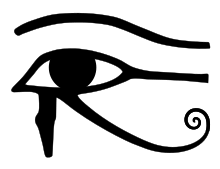 |
|
Beliefs |
|
Practices |
|
Characters |
|
Locations |
|
Symbols and Objects
|
|
Related religions |
|
|
The ancient Egyptians had an elaborate set of funerary practices that they believed were necessary to ensure their immortality after death (the afterlife). These rituals and protocols included mummifying the body, casting magic spells, and burial with specific grave goods thought to be needed in the Egyptian afterlife.[1][2]
The ancient Egyptian burial process evolved over time as old customs were discarded and new ones adopted, but several important elements of the process persisted. Although specific details changed over time, the preparation of the body, the magic rituals, and grave goods were all essential parts of a proper Egyptian funeral.
There were many different gods to prepare for. The ancient Egyptians believed that each god would separately judge the deceased before he could enter the afterlife.
History
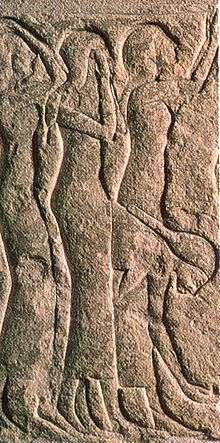
| Dynasties of Ancient Egypt |
|---|
Although no writing survives from Predynastic Egypt, scholars believe the importance of the physical body and its preservation originated there. This would explain why people of that time did not follow the common practice of cremation, but rather buried the dead. Some also believe they may have feared the bodies would rise again if mistreated after death.[3]
Early bodies were buried in simple, shallow oval pits, with a few burial goods. Sometimes multiple people and animals were placed in the same grave. Over time, graves became more complex, with the body placed in a wicker basket, then later in wooden or terracotta coffins. The latest tombs Egyptians made were sarcophaguses. These graves contained burial goods like jewelry, food, games and sharpened splint.[4]
This demonstrates that this ancient period had a sense of the afterlife, though archaeological evidence may show the average person had little chance of getting into it. This may be because admission required that the deceased must be able to serve a purpose there. The pharaoh was allowed in because of his role in life, and others needed to have some role there.
Human sacrifices found in early royal tombs reinforce this view. These people were probably meant to serve the pharaoh during his eternal life. Eventually, figurines and wall paintings begin to replace human victims.[5] Some of these figurines may have been created to resemble certain people, so they could follow the pharaoh after their lives ended.
Note that not only the lower classes had to rely on the pharaoh's favor, but also the noble classes. They believed that when he died, the pharaoh became a type of god, who could bestow upon certain individuals the ability to have an afterlife. This belief existed from the predynastic period through the Old Kingdom.
Although many spells from the predeceasing texts were carried over, the new coffin texts also had additional new spells added, along with slight changes made to make this new funerary text more relatable to the nobility.[6] In the First Intermediate Period, however, the importance of the pharaoh declined. Funerary texts, previously restricted to royal use, became more widely available. The pharaoh was no longer a god-king in the sense that only he was allowed in the next life due to his status here, now he was merely the ruler of the population who upon his death would be leveled down towards the plane of the mortals.[7]
Prehistory, earliest burials
The first funerals in Egypt are known from the villages of Omari and Maadi in the north. The people of these villages buried their dead in a simple, round graves with one pot. The body was neither treated nor arranged in a regular way as would be the case later in the historical period. Without any written evidence, there is little to provide information about contemporary beliefs concerning the afterlife except for the regular inclusion of a single pot in the grave. In view of later customs, the pot was probably intended to hold food for the deceased.[8]
Predynastic period, development of customs
Funerary customs developed during the Predynastic period from those of the Prehistoric Period. At first people excavated round graves with one pot in the Badarian Period (4400-3800 B.C.E.), continuing the tradition of Omari and Maadi cultures. By the end of the Predynastic period, there were increasing numbers of objects deposited with the body in rectangular graves, and there is growing evidence of rituals practiced by Egyptians of the Naquada II Period (3650-3300 B.C.E). At this point, bodies were regularly arranged in a crouched or fetal position with the face toward either the east the rising sun or the west (which in this historical period was the land of the dead). Artists painted jars with funeral processions and perhaps ritual dancing. Figures of bare breasted women with birdlike faces and their legs concealed under skirts also appeared in some graves. Some graves were much richer in goods than others, demonstrating the beginnings of social stratification. Gender differences in burial emerged with the inclusion of weapons in men's graves and cosmetics palettes in women's graves.[9]
Early Dynastic Period, tombs and coffins
By the First Dynasty, some Egyptians were wealthy enough to build tombs over their burials rather than placing their bodies in simple pit graves dug into the sand. The rectangular, mud-brick tomb with an underground burial chamber, called a mastaba, developed in this period. These tombs had niched walls, a style of building called the palace-façade motif because the walls imitated those surrounding the palace of the king. Since commoners as well as kings, however, had such tombs, the architecture suggests that in death, some wealthy people did achieve an elevated status. Later in the historical period, it is certain that the deceased was associated with the god of the dead, Osiris.
Grave goods expanded to include furniture, jewelry, and games as well as the weapons, cosmetic palettes, and food supplies in decorated jars known earlier, in the Predynastic period. Now, however, in the richest tombs, grave goods numbered in the thousands. Only the newly invented coffins for the body were made specifically for the tomb. There is also some inconclusive evidence for mummification. Other objects in the tombs that had been used during daily life suggests that Egyptians already in the First Dynasty anticipated needing in the next life. Further continuity from this life into the next can be found in the positioning of tombs: those persons who served the king during their lifetimes chose burials in close proximity to their lord. The use of stela in front of the tomb began in the First Dynasty, indicating a desire to individualize the tomb with the deceased's name.[10]
Old Kingdom, pyramids and mummification
In the Old Kingdom, kings first built pyramids for their own tombs surrounded by stone mastaba tombs for their high officials. The fact that most high officials were also royal relatives suggests another motivation for such placement: these complexes were also family cemeteries.
Among the elite, bodies were now mummified, wrapped in linen bandages, sometimes covered with molded plaster, and placed in stone sarcophagi or plain wooden coffins. At the end of the Old Kingdom, mummy masks in cartonnage (linen soaked in plaster, modeled and painted) also appeared. Canopic containers now held their internal organs. Amulets of gold, faience, and carnelian first appeared in various shapes to protect different parts of the body. There is also first evidence of inscriptions inside the coffins of the elite during the Old Kingdom. Often, reliefs of every day items were etched onto the walls supplemented grave goods, which made them available through their representation.
The new false door was a non-functioning stone sculpture of a door into the tomb, found either inside the chapel or on the outside of the mastaba; it served as a place to make offerings and recite prayers for the deceased. Statues of the deceased were now included in tombs and used for ritual purposes. Burial chambers of some private people received their first decorations in addition to the decoration of the chapels. At the end of the Old Kingdom, the burial chamber decorations depicted offerings, but not people.[11]
First Intermediate Period, regional variation
The political situation in the First Intermediate Period, with many centers of power, is clearly reflected in the many local styles of art and burial at this time. The many regional styles for decorating coffins make their origins easy to distinguish from each other. For example, some coffins have one-line inscriptions, and many styles include the depiction of wadjet eyes (the human eye with the markings of a falcon). There are also regional variations in the hieroglyphs used to decorate coffins.
Occasionally men had tools and weapons in their graves, while some women had jewelry and cosmetic objects such as mirrors. Grindstones were sometimes included in women's tombs, perhaps to be considered a tool for food preparation in the next world, just as the weapons in men's tombs imply men's assignment to a role in fighting.[12]
Middle Kingdom, new tomb contents
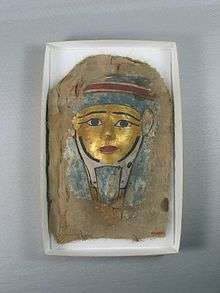
Burial customs in the Middle Kingdom reflect some of the political trends of this period. During the Eleventh Dynasty, tombs were cut into the mountains of Thebes surrounding the king's tomb or in local cemeteries in Upper and Middle Egypt; Thebes was the native city of the Eleventh Dynasty kings, and they preferred to be buried there. But the Twelfth Dynasty, high officials served the kings of a new family now ruling from the north in Lisht; these kings and their high officials preferred burial in a mastaba near the pyramids belonging to their masters. Moreover, the difference in topography between Thebes and Lisht led to a difference tomb type: in the north, nobles build mastaba tombs on the flat desert plains, while in the south, local dignitaries continued to excavate tombs in the mountain.
For those of ranks lower than royal courtiers during the Eleventh Dynasty, tombs were simpler. Coffins could be simple wooded boxes with the body either mummified and wrapped in linen or simply wrapped without mummification, and the addition of a cartonnage mummy mask. Some tombs included wooded shoes and a simple statue near the body. In one burial there were only twelve loaves of bread, a leg of beef, and a jar of beer for food offerings. Jewelry could be included but only rarely were objects of great value found in non-elite graves. Some burials continued to include the wooden models that were popular during the First Intermediate Period. Wooden models of boats, scenes of food production, craftsmen and workshops, and professions such as scribes or soldiers have been found in the tombs of this period.
Some rectangular coffins of the Twelfth Dynasty have short inscriptions and representations of the most important offerings the deceased required. For men the objects depicted were weapons and symbols of office as well as food. Women's coffins depicted mirrors, sandals, and jars containing food and drink. Some coffins included texts that were later versions of the royal Pyramid Texts.
Another kind of faience model of the deceased as a mummy seems to anticipate the use of shabty figurines (also called shawabty or an ushabty) later in the Twelfth Dynasty. These early figurines do not have the text directing the figure to work in the place of the deceased that is found in later figurines. The richest people had stone figurines that seem to anticipate shabties, though some scholars have seen them as mummy substitutes rather than servant figures.
In the later Twelfth Dynasty, significant changes occurred in burials, perhaps reflecting administrative changes enacted by King Senwosret III (1836-1818 B.C.E.). The body was now regularly placed on its back, rather than its side as had been done for thousands of years. Coffin texts and wooden models disappeared from new tombs of the period while heart scarabs and figurines shaped like mummies were now often included in burials, as they would be for the remainder of Egyptian history. Coffin decoration was simplified. The Thirteenth Dynasty saw another change in decoration. Different motifs were found in the north and south, a reflection of decentralized government power at the time. There were also a marked increase in the number of burials in one tomb, a rare occurrence in earlier periods. The reuse of one tomb by a family over generations seems to have occurred when wealth was more equitably spread.[13]
Second Intermediate Period, foreigner burials
Known graves from the Second Intermediate Period reveal the presence of non-Egyptians buried in the country. In the north, graves associated with the Hyksos, a western Semitic people ruling the north from the northeast delta, include small mud brick structures containing the body, pottery vessels, a dagger in a men's graves and often a nearby donkey burial. Simple pan-shaped graves in various parts of the country are thought to belong to Nubian soldiers. Such graves reflect very ancient customs and feature shallow, round pits, bodies contracted and minimal food offerings in pots. The occasional inclusion of identifiable Egyptian materials from the Second Intermediate Period provides the only marks distinguishing these burials from those of Predynastic and even earlier periods.[14]
New Kingdom, new object purposes
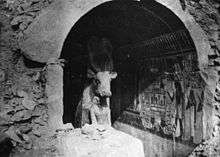
The majority of elite tombs in the New Kingdom were rock-cut chambers. Kings were buried in multi-roomed, rock-cut tombs in the Valley of the Kings and no longer in pyramids. Priests conducted funerary rituals for them in stone temples built on the west bank of the Nile opposite of Thebes. From the current evidence, the Eighteenth Dynasty appears to be the last period in which Egyptians regularly included multiple objects from their daily lives in their tombs; beginning in the Nineteenth Dynasty, tombs contained fewer items from daily life and included objects made especially for the next world. Thus the change from the Eighteenth to the Nineteenth Dynasties formed a dividing line in burial traditions: The Eighteenth Dynasty more closely remembered the immediate past in its customs whereas the Nineteenth Dynasty anticipated the customs of the Late Period.
People of the elite ranks in the Eighteenth Dynasty placed furniture as well as clothing and other items in their tombs, objects they undoubtedly used during life on earth. Beds, headrests, chairs, stools, leather sandals, jewelry, musical instruments, and wooden storage chests were present in these tombs. While all of the objects listed were for the elite, many poor people did not put anything beyond weapons and cosmetics into their tombs.
No elite tombs survive unplundered from the Ramesside period. In this period, artists decorated tombs belonging to the elite with more scene of religious events, rather than the everyday scene that had been popular since the Old Kingdom. The funeral itself, the funerary meal with multiple relatives, the worshipping of the gods, even figures in the underworld were subjects in elite tomb decorations. The majority of objects found in Ramesside period tombs were made for the afterlife. Aside from the jewelry, which could have been used also during life, objects in Ramesside tombs were manufactured for the next world.[15]
Third Intermediate Period

Although the political structure of the New Kingdom collapsed at the end of the Twentieth Dynasty, the majority of burials in the Twenty-first Dynasty directly reflect developments from the earlier period. At the beginning of this time, reliefs resembled those from the Ramesside period. Only at the very end of the Third Intermediate Period did new funerary practices of the Late Period begin to be seen.
Little is known of tombs from this period. The very lack of decorations in tombs seem to have led to much more elaborate decoration of coffins. The remaining grave goods of the period show fairly cheaply made shabties, even when the owner was a queen or a princess.[16]
Late Period, monumentality and return to traditions
Burials in the Late Period could make use of large-scale, temple like tombs built for the non-royal elite for the first time. But the majority of tombs in this period were in shafts sunk into the desert floor. In addition to fine statuary and reliefs reflecting the style of the Old Kingdom, the majority of grave goods were specially made for the tomb. Coffins continued to bear religious texts and scenes. Some shafts were personalized by the use of stela with the deceased prayers and name on it. Shabties in faience for all classes are known. Canopic jars, though often nonfunctional, continued to be included. Staves and scepters representing the deceased's office in life were often present as well. A figure of either the god Osiris or of the composite deity Ptah-Soker-Osiris could be found, along with heart scarabs, both gold and faience examples of djed-columns, Eye of Horus amulets, figures of gods, and images of the deceased's ba. Tools for the tombs ritual called the "opening of the mouth" as well as "magical bricks" at the four compass points could be included.[17]
Ptolemaic period, Hellenistic influences
Following Egypt's conquest by Alexander the Great, the country was ruled by the descendants of Ptolemy, one of his generals. The Macedonian Greek family fostered a culture that promoted both Hellenistic and ancient Egyptian ways of life: while many Greek-speaking people living in Alexandria followed the customs of mainland Greece, others adopted Egyptian customs, while Egyptians continued to follow their own already ancient customs.
Very few Ptolemaic tombs are known. Fine temple statuary of the period suggests the possibility of tomb sculpture and offering tables. Egyptian elite burials still made use of stone sarcophagi. Books of the Dead and amulets were also still popular.[18]
Roman period, Roman influences

The Romans conquered Egypt in 30 B.C., ending the rule of the last and most famous member of the Ptolemaic dynasty, Cleopatra VII. During Roman rule, an elite hybrid burial style developed incorporating both Egyptian and Roman elements.
Some people were mummified and wrapped in linen bandages. The front of the mummy was often painted with a selection of traditional Egyptian symbols. Mummy masks in either traditional Egyptian style or in Roman style could be added to the mummies. Another possibility was a Roman-style mummy portrait, executed in encaustic (pigment suspended in wax) on a wooden panel. Sometimes the feet of the mummy were covered. An alternative to this was a complete shroud with Egyptian motifs but a portrait in the Roman style. Tombs of the elite could also include fine jewelry.[19]
Funerary rituals
Greek historians Herodotus (5th century BC) and Diodorus Siculus (1st century BC) provide the most complete, surviving evidence of how Ancient Egyptians approached the preservation of a dead body.[20] Before embalming, or preserving the dead body as to delay or prevent decay, mourners, especially if the deceased had high status, covered their faces with mud, and paraded around town while beating their chests.[20] If the wife of a high status male died, her body was not embalmed until three or four days have passed, because this prevented abuse of the corpse.[20] In the case that someone drowned or was attacked, embalming was carried out immediately on their body, in a sacred and careful manner. This kind of death was viewed as venerated, and only priests was permitted to touch the body.[20]
After embalming, the mourners may have carried out a ritual involving an enactment of judgement during the Hour Vigil, with volunteers to play the role of Osiris and his enemy brother Seth, as well as the gods Isis, Nephthys, Horus, Anubis, and Thoth.[21] As the tale goes, Seth was envious of his brother Osiris for being granted the throne before him, so he plotted to kill him. Osiris's wife, Isis, battled back and forth with Seth to gain possession of Osiris's body, and through this struggle, Osiris's spirit was lost.[22] Nonetheless, Osiris resurrected and was reinstated as a god.[23] In addition to the reenactment of the judgement of Osiris, numerous funeral processions were conducted throughout the nearby necropolis, which symbolized different sacred journeys.[21]
The funeral procession to the tomb generally included cattle pulling the body in a sled-type of carrier, with friends and family to follow. During the procession the priest burned incense and poured milk before the dead body.[21] Upon arrival to the tomb, and essentially the next life, the priest performed the Opening of The Mouth ceremony on the deceased. The deceased's head was turned towards the south, and the body was imagined to be a statue replica of the deceased. Opening the mouth of the deceased symbolized allowing the person to speak and defend themselves during the judgment process. Goods were then offered to the deceased to conclude the ceremony.[21]
Mummification
Embalming
The preservation of a dead body was critical if the deceased wanted a chance at acceptance into the afterlife. Within the Ancient Egyptian concept of the soul, ka, which represented vitality, leaves the body once the person dies.[24] Only if the body is embalmed in a specific fashion will ka return to the deceased body, and rebirth will take place.[20] The embalmers received the body after death, and in a systematized manner, prepared it for mummification. The family and friends of the deceased had a choice of options that ranged in price for the preparation of the body, similar to the process at modern funeral homes. Next, the embalmers escorted the body to ibw, translated to “place of purification,” a tent in which the body was washed, and then per nefer, “the House of Beauty,” where mummification took place.[20]
Mummification process
In order to live for all eternity and be presented in front of Osiris, the body of the deceased had to be preserved by mummification, so that the soul could reunite with it, and take pleasure in the afterlife. The main process of mummification was preserving the body by dehydrating it using natron, a natural material found in Wadi Natrun which is like a combination of baking soda and salt. The body is drained of any liquids and left with the skin, hair and muscles preserved.[25]
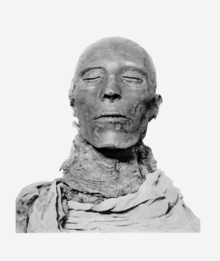
The process of mummification was available for anyone who could afford it. It was believed that even those who could not afford this process could still enjoy the afterlife with the right reciting of spells. Mummification existed in three different processes, ranging from most expensive, moderately expensive, and most simplistic, or cheapest.[20] The most classic, common, and most expensive method of mummification dates back to the 18th Dynasty. The first step was to remove the internal organs and liquid so that the body would not decay. The embalmers took out the brain through a process named excerebration by inserting a metal hook through the nostril, breaking through it into the brain. They removed as much as they could with the hook, and the rest they liquefied with drugs and drained out.[20] They threw out the brain because they thought that the heart did all the thinking. The next step was to remove the internal organs, the lungs, liver, stomach, and intestines, and place them in canopic jars with lids shaped like the heads of the protective deities, the four sons of Horus: Imsety, Hapy, Duamutef, and Qebhseneuf. Imsety was human-headed, and guarded the liver; Hapy was ape-headed, and guarded the lungs; Duamutef was jackel-headed, and guarded the stomach; Qebhseneuf was hawk-headed, and guarded the small and large intestines.[25] Sometimes the four canopic jars were placed into a canopic chest, and buried with the mummified body. A canopic chest resembled a "miniature coffin" and was intricately painted. The Ancient Egyptians believed that by burying the deceased with their organs, they may rejoin with them in the afterlife.[26] Other times, the organs were cleaned and cleansed, and the returned into the body.[20] The body cavity was then rinsed and cleaned with wine and an array of spices. The body was sewn up with aromatic plants and spices left inside.[20] The heart stayed in the body, because in the hall of judgment, it would be weighed against the feather of Ma'at. After the body was washed with wine, it was stuffed with bags of natron. The dehydration process took 40 days.[27]
The second part of the process took 30 days. This was the time where the deceased turned into a semi divine being, and all that was left in the body from the first part was removed, followed by applying first wine and then oils. The oils were for ritual purposes, as well as for preventing the limbs and bones from breaking while being wrapped. The body was sometimes colored with a golden resin, which protected the body from bacteria and insects. Additionally, this practice was based on the belief that divine beings had flesh of gold. Next, the body was wrapped in linen cut into strips with amulets while a priest recited prayers and burned incense. The linen was adhered to the body using gum, opposed to a glue.[20] The dressing provided the body physical protection from the elements, and depending on how wealthy the deceased's family was, the deceased could be dressed with an ornamented funeral mask and shroud.[20] Special care was given to the head, hands, feet, and genitals, as contemporary mummies reveal extra wrappings and paddings in these areas.[26] Mummies were identified via small, wooden name-tags tied typically around the deceased's neck.[20] The 70-day process is connected to Osiris and the length the star Sothis was absent from the sky.[28]
The second, moderately expensive option for mummification did not involve an incision into the abdominal cavity or the removal of the internal organs. Instead, the embalmers injected the oil of a cedar tree into the body, which prevented liquid from leaving the body. The body was then laid in natron for a specific number of days. The oil was then drained out of the body, and with it came the internal organs, the stomach and the intestines, which were liquefied by the cedar oil. The flesh dissolved in the natron, which left only skin and bones left of the deceased body. The remains are given back to the family.[20] The cheapest, most basic method of mummification, which was often chosen by the poor, involved purging out the deceased's internal organs, and then laying the body in natron for 70 days. The body was then given back to the family.[20]
Burial rituals
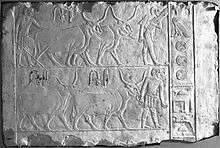
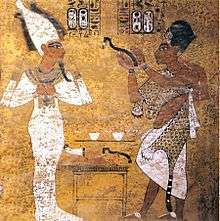
After the mummy was prepared, it would need to be re-animated, symbolically, by a priest. The opening of the mouth ceremony was conducted by a priest who would utter a spell and touch the mummy or sarcophagus with a ceremonial adze – a copper or stone blade. This ceremony ensured that the mummy could breathe and speak in the afterlife. In a similar fashion, the priest could utter spells to reanimate the mummy's arms, legs, and other body parts.
The priests, maybe even the king's successor, move the body through the causeway to the mortuary temple. This is where prayers were recited, incense was burned, and more rituals were performed to help prepare the king for his final journey. The king's mummy was then placed inside the pyramid along with enormous amount of food, drink, furniture, clothes, and jewelry which were to be used in the afterlife.
The pyramid was sealed so that no one would ever enter it again. However the king's soul could move through the burial chamber as it wished. After the funeral the king becomes a god and could be worshipped in the temples beside his pyramid.[27]
In ancient times Egyptians were buried directly in the ground. Since the weather was so hot and dry, it was easy for the bodies to remain preserved. Usually the bodies would be buried in the fetal position.[28] Ancient Egyptians believed the burial process to be an important part in sending humans to a comfortable afterlife. The Egyptians believed that, after death, the deceased could still have such feelings of anger, or hold a grudge as the living. The deceased were also expected to support and help their living family.[29] They believed that the Ba and Ka are what enabled the dead to support their family. The Ba made it possible for an invisible twin to be released from the body to support the family, while the Ka would recognize the twin when it would come back to the body.[30] With the ideas of the dead being so valuable, it is clear why the Egyptians treated the deceased with respect. The less fortunate Egyptians still wanted their family members to be given a proper burial. A typical burial would be held in the desert where the family would wrap the body in a cloth and bury it with everyday objects for the dead to be comfortable.[31] Although some could afford mummification, most commoners were not mummified due to the expense.[32] Oftentimes, the poor are found in mass graves where their bodies are not mummified and only with minimal household objects. If you were to find the bodies of the poor in Egypt they would be spread out throughout the desert, often in areas that are now populated.
Tombs

The tomb was the housing for the deceased and served two crucial functions: the tomb provided infinite protection for the deceased to rest, as well as a place for mourners to perform rituals in which aided the deceased into eternal life. Therefore, the Ancient Egyptians were very serious about the way in which the tombs were built.[33] Two hallmarks of the tomb included (1) a burial chamber, which housed the physical body of the deceased (inside a coffin) as well as funerary objects deemed most important, and (2) A "cult place," which resembled a chapel where mourners, family, and friends could congregate. The tomb of a king included a full temple, instead of a chapel.[33]
Typically, the tomb of a deceased person was located somewhere close-by their home community. The Ancient Egyptians opted to bury the deceased in land that was not particularly fertile or useful for vegetation. Therefore, tombs were mostly build in desert areas. Tombs were usually built near each other, and rarely stood alone. For a deceased king, however, the tomb was located in a place of utmost sacredness.[33]
In the Prehistoric Egypt, bodies were buried in deserts because they would naturally be preserved by dehydration. The "graves" were small oval or rectangular pits dug in the sand. They could give the body of the deceased in a tight position on its left side alongside a few jars of food and drink and slate palettes with magical religious spells. The size of graves eventually increased but according to status and wealth. The dry, desert conditions were a benefit in ancient Egypt for burials of the poor, who could not afford the complex burial preparations that the wealthy had.
The simple graves evolved into mudbrick structures called mastabas. Royal mastabas later developed into "step pyramids" and then "true pyramids."[34] As soon as a king took the throne he would start to build his pyramid. Rituals of the burial, including the "Opening of the mouth ceremony" took place at the Valley Temple.[27][35] While a pyramid's large size was made to protect against robbery, it may also be connected to a religious belief about the sun god, Ra.[36]
A majority of cemeteries were located on the west bank of the Nile, which was metaphorically viewed as "the realm of the dead." The tomb was said to represent the deceased's place in the cosmos, which ultimately depended on the social class of the deceased. If the deceased was of a notably high-class, they were buried near the king, whereas middle and lower class individuals were simply buried near the communities in which they had lived.[33] In many cases, the tombs of the high-class were situated in accordance with the tombs of the lower classes so that they would be viewed as a "focal point." For example, one burial site was designed so that the tombs of the governors were placed alongside the slope of a hill, whereas the tombs of the governor's attendants were placed at the foot of the hill.[33]
Coffins
After having been preserved, the mummy was placed into a coffin. Although the coffins that housed the deceased bodies were made simply of wood, they were intricately painted and designed to suit each individual. During the Old Kingdom, the following was included on each coffin: the title of the deceased, a list of offerings, a false compartment through which ka could pass through, and painted eyes so that the deceased could look through the coffin.[37] The decorations on the coffin usually fit the deceased's status.
During the Middle Kingdom, the coffin was treated as if it were a "miniature tomb" and was painted and inscribed like so. Goddesses Isis and Nephthys were painted on the coffins, and were said to guard the deceased in the afterlife. Along the sides of the coffins, the four sons of Horus were painted, amongst other gods. Prayers were often inscribed on the coffins as well.[37]
Anthropoid coffins soon emerged, which were tailored to the contour of the deceased's body. The deceased's face and hair was painted onto the coffin so to personalize it further.[37] A sarcophagus, which is a large, stone container, was used to house the coffin, and provide supplementary protection to the dead body. The Ancient Egyptians translated the word "sarcophagus" to mean "possessor of life," and therefore, the sarcophagus would aid the deceased into the afterlife.[38]
Damnation
One of the funerary practices followed by the Egyptians was preparing properly for the afterlife. Ka, the vital force within the Ancient Egyptian concept of the soul, would not return to the deceased body if embalming was not carried out in the proper fashion.[24] In this case, the body decayed, and possibly became unrecognizable, which rendered the afterlife unattainable for the deceased person.[20] If the proper precautions were not taken, damnation would occur. Damnation meant that Egyptians would not experience the glories of the afterlife where they became a deified figure and would be welcomed by the Gods.[39] Instead, damnation was depicted in the books of the underworld. It was a place of opposites; chaos, fire, and struggle.[39] Different pages of the books of the underworld depict different perspectives of what happens during damnation. It discusses cutting out humanity and individuality from the person and reversing the cosmic order.[39]
Funerary texts
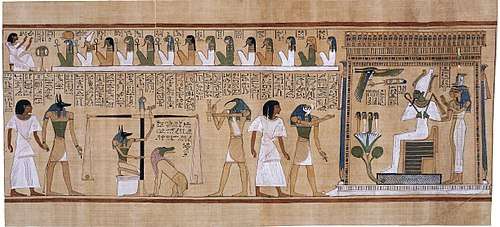
Many mummies were provided with some form of funerary literature to take with them to the afterlife. Most funerary literature consists of lists of spells and instructions for navigating the afterlife. During the Old Kingdom, only the pharaoh had access to this material, which scholars refer to as the Pyramid Texts. The Pyramid Texts are a collection of spells to assure the royal resurrection and protect the pharaoh from various malignant influences. The Pharaoh Unas was the first to use this collection of spells, as he and a few subsequent pharaohs had them carved on the walls of their pyramids.[40] These texts were individually chosen from a larger bank of spells.
In the First Intermediate Period and in the Middle Kingdom, some of the Pyramid Text spells also are found in burial chambers of high officials and on many coffins, where they begin to evolve into what scholars call the Coffin Texts. In this period, the nobles and many non-royal Egyptians began to have access to funerary literature. Although many spells from the earlier texts were carried over, the new coffin texts also had additional spells, along with slight changes made to make this new funerary text more fit for the nobility.[6]
In The New Kingdom, the Coffin texts became the Book of the Dead, or the Funeral Papyri, and would last through the Late Kingdom. The text in these books was divided according to chapters/ spells, which were almost two-hundred in number. Each one of these texts was individualized for the deceased, though to varying degrees. If the person was rich enough, then they could commission their own personal version of the text that would include only the spells that they wanted. However, if one was not so wealthy, then one had to make do with the pre-made versions that had spaces left for the name of the deceased.
If the scribe ran out of room while doing the transcription, he would just stop the spell wherever he was and would not continue.[41] It is not until the Twenty-sixth Dynasty that there began to be any regulation of the order or even the number of spells that were to be included in the Book of the Dead. At this time, the regulation is set at 192 spells to be placed in the book, with certain ones holding the same place at all times.[42] This makes it seem as if the order of the texts was not what was important, so the person could place them in an order that he was comfortable with, but rather that it was what was written that mattered.
Judgement
The idea of judgement went as follows: in order to be considered for the admittance into the afterlife, those who died were obligated to undergo a multi-step judgement by certain gods.[33] The concept and belief in judgement is outlined in the Book of the Dead, a funerary text of the new kingdom. The Book of the Dead is composed of spells relating to the deceased and the afterlife. Spell 125, in particular, is understood to be delivered by the deceased at the outset of the judgement process.[33]
The visual picture of what judgement looks like has been discovered through Ancient Egyptian ruins and artifacts. The procedure was depicted as follows: The deceased's heart was weighed in comparison to a feather, while a vicious beast awaited to eat the heart (if the deceased was found to be a sinner).[33] Osiris was the judge (among others), and represented an ideal output of the judgement process for the deceased who entered his judgement hall. This is because he resurrected and regained his godly status after he was justified against his brother Seth, who wrongly murdered him.[23] The deceased pleaded to Osiris, among 42 judges, that they had not committed sin, which is known as a "negative confession."[23]
The 42 judges assessed how virtuous the life of the deceased was, and this represented the principle element of the deceased entering the afterlife. After passing judgement, the family and friends of the deceased celebrated them and boasted about their righteousness to attain entry into the afterlife.[20]
Burial goods
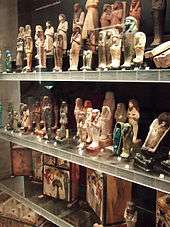
Although the types of burial goods changed throughout ancient Egyptian history, their purpose to protect the deceased and provide sustenance the afterlife remained.
From the earliest periods of Egyptian history, all Egyptians were buried with at least some goods that they thought were necessary after death. At a minimum, these consisted of everyday objects such as bowls, combs, and other trinkets, along with food. Wealthier Egyptians could afford to be buried with jewelry, furniture, and other valuables, which made them targets of tomb robbers. In the early Dynastic Period, tombs were filled with daily life objects, such as furniture, jewelry and other valuables. They also contained many pottery and stone vessels.[43]
As burial customs developed in the Old Kingdom, wealthy citizens were buried in wooden or stone coffins. However, the number of burial goods declined. They were often just a set of copper model copper tools and some vessels.[44] Starting in the First Intermediate period, wooden models became very popular burial goods. These wooden models often depict everyday activities that the deceased expected to continue doing in the afterlife. Also, a type of rectangular coffin became the standard, being brightly painted and often including an offering formula. Objects of daily use were not often included in the tombs during this period.
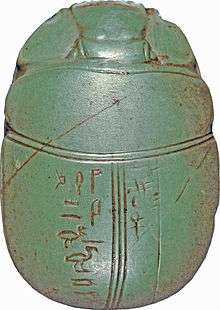
At the end of the Middle Kingdom, new object types were introduced into burials, such as the first shabtis and the first heart scarabs. Shabtis were little clay statues made to perform tasks on command for the pharaoh. Now objects of daily use appear in tombs again, often magical items already employed for protecting the living. Scarabs (beetles) collect animal dung and roll it into little balls. To the Egyptians, these balls looked like the life-giving Sun, so they hoped that scarabs would bring them long life. Scarabs have been found in tombs and graves.[45]
In the New Kingdom, some of the old burial customs changed. For example, an anthropoid coffin shape became standardized, and the deceased were provided with a small shabti statue, which the Egyptians believed would perform work for them in the afterlife. Elite burials were often filled with objects of daily use. Under Ramses II and later all daily life objects disappear from tombs. They most often only contained a selection of items especially made for the burial. Also, in later burials, the numbers of shabti statues increased; in some burials, numbering more than four hundred statues. In addition to these shabti statues, the deceased could be buried with many different types of magical figurines to protect them from harm.
Funerary Boats
Funerary boats are a part of some ancient Egyptian burials.[46] Boats played a major role in religion because they were conceived as the main means by which the gods traveled across the sky and through the netherworld. One type of boat used at funerals was for making pilgrimages to holy sites such as Abydos. A large funerary boat, for example, was found near the pyramid of the Old Kingdom Pharaoh Cheops. The funerary boats are called Felucca and they are usually made of wood and the Egyptians used a collection of papyrus reeds and tie them together with the wood very tightly.[47] The most common route for funerary boats is the River Nile to the afterlife. The boat carries the coffin and they have a dog in the boat because they usually lead the deceased to the afterlife.[48] The boats are measured around 20 feet or larger in length but it doesn't match the quality of great pharaohs like Pharaoh Khufu the one that built the Great Pyramid. His funerary boat size was around 144 foot long with 12 oars. Common funerary boats are small sized and new oars.[49]
Role of Animals
Several kinds of animal remains have been discovered in tombs all around Dayr al-Barsha, a Coptic village in Middle Egypt. The remains found in the shafts and burial chambers included dogs, foxes, eagle owls, bats, rodents, and snakes. These were determined to be individuals that had entered the deposits by accident. Other animal remains that were found were more common and recurred more than those individuals that wound up accidentally trapped in these tombs. These remains included numerous gazelle and cattle bones, as well as calves and goats which were believed to have been in result of human behavior. This was due to finding that some remains had fragments altered, missing, or separated from their original skeletons. These remains also had traces of paint and cut marks on them, seen especially with cattle skulls and feet. Based on this, the natural environment of the Dayr al-Barsha tombs, and the fact that only some parts of these animals were found, the possibility of natural deposition can be ruled out, and the cause of these remains in fact are most likely caused by animal sacrifices, as only the head, foreleg, and feet were apparently selected for deposition within the tombs. According to a study by Christopher Eyre, cattle meat was actually not a part of the daily diet in Ancient Egypt, as the consumption of meat only took place during celebrations including funerary and mortuary rituals, and the practice of providing the deceased with offerings of cattle going back to the Predynastic Period.[50]
See also
References
- ↑ Digital Egypt, Burial customs
- ↑ Ancient Egyptian Mummies: A Web Quest for 4th-6th Grade (Social Studies), Lee Anne Brandt. Retrieved from the Wayback Machine internet archive on May 8, 2013.
- ↑ Françoise Dunand and Roger Lichtenberg, Mummies and Death in Egypt, (London: Cornell University Press, 2006), p. 9
- ↑ Françoise Dunand and Roger Lichtenberg, Mummies and Death in Egypt, (London: Cornell University Press, 2006), p. 7
- ↑ Sergio Donadoni, The Egyptians, (Chicago: University of Chicago Press, 1997) p. 262
- 1 2 Erik Hornung, The Ancient Egyptian Book of the Afterlife, (Cornell: Cornell University Press, 1999) p. 7
- ↑ John A. Wilson, The Culture of Ancient Egypt, (Chicago: University of Chicago Press, 1965), p. 116.
- ↑ Bleiberg, Edward (2008). To Live Forever: Egyptian Treasure from the Brooklyn Museum. Brooklyn, NY: Brooklyn Museum. p. 71.
- ↑ Bleiberg, Edward (2008). To Live Forever: Egyptian Treasure from the Brooklyn Museum. Brooklyn, NY: Brooklyn Museum. pp. 71–72.
- ↑ Bleiberg, Edward (2008). To Live Forever: Egyptian Treasure from the Brooklyn Museum. Brooklyn, NY: Brooklyn Museum. pp. 72–73.
- ↑ Bleiberg, Edward (2008). To Live Forever: Egyptian Treasure from the Brooklyn Museum. Brooklyn, NY: Brooklyn Museum. pp. 74–77.
- ↑ Bleiberg, Edward (2008). To Live Forever: Egyptian Treasure from the Brooklyn Museum. Brooklyn, NY: Brooklyn Museum. p. 77.
- ↑ Bleiberg, Edward (2008). To Live Forever: Egyptian Treasure from the Brooklyn Museum. Brooklyn, NY: Brooklyn Museum. pp. 77–86.
- ↑ Bleiberg, Edward (2008). To Live Forever: Egyptian Treasure from the Brooklyn Museum. Brooklyn, New York: Brooklyn Museum. pp. 86–89.
- ↑ Bleiberg, Edward (2008). To Live Forever: Egyptian Treasure from the Brooklyn Museum. Brooklyn, New York: Brooklyn Museum. pp. 89–100.
- ↑ Bleiberg, Edward (2008). To Live Forever: Egyptian Treasure from the Brooklyn Museum. Brooklyn, NY: Brooklyn Museum. pp. 100–103.
- ↑ Bleiberg, Edward (2008). To Live Forever: Egyptian Treasure from the Brooklyn Museum. Brooklyn, New York: Brooklyn Museum. p. 103.
- ↑ Bleiberg, Edward (2008). To Live Forever: Egyptian Treasure from the Brooklyn Museum. Brooklyn, NY: Brooklyn Museum. p. 103.
- ↑ Bleiberg, Edward (2008). To Live Forever: Egyptian Treasure from the Brooklyn Museum. Brooklyn, NY: Brooklyn Museum. pp. 103–106.
- 1 2 3 4 5 6 7 8 9 10 11 12 13 14 15 16 17 Tomorad, Mladen (May 2009). "Ancient Egyptian funerary practices from the first millennium BC to the Arab conquest of Egypt (c. 1069 BC-642 AD)". The Heritage of Egypt. 2: 12–28.
- 1 2 3 4 Harold, Hays, (2010-01-22). "Funerary Rituals (Pharaonic Period)". 1 (1).
- ↑ "Gods of Ancient Egypt: Isis, Osiris and Horus". ancientegyptonline.co.uk. Retrieved 2018-03-13.
- 1 2 3 Mark, Smith, (2008-10-27). "Osiris and the Deceased". 1 (1).
- 1 2 "THE AFTERLIFE in Ancient Egypt". 2008-04-21. Retrieved 2018-03-12.
- ↑ Salima Ikram, Ancient Egypt, pp. 275–282
- ↑ Christina, Riggs, (2010-01-22). "Funerary rituals (Ptolemaic and Roman Periods)". 1 (1).
- 1 2 Janice Kamrin and Salima Ikram, pp. 10–11
- ↑ Burial Practices, Afterlife, & Mummies – Rosicrucian Egyptian Museum in San Jose Houses the Largest Collection of Egyptian Artifacts on Exhibit in Western North America. Web. 02 Dec. 2013.
- ↑ "The Dead and The Living." reshafim.org. N.p., n.d. Web. 24 Nov. 2013 <https://www.reshafim.org.il/ad/egypt/religion/ancestorworship.htm>
- ↑ "How Were Other Ancient Egyptians Buried." Ancient Egypt.co.uk. Trustees of the British Museum, n.d. Web. 27 Nov. 2013.<https://www.ancientegypt.co.uk/ pyramids/about/otheregy.html>
- ↑ British Museum, n.d. Web. 27 Nov. 2013. <https://www.ancientegypt.co.uk/ pyramids/about/otheregy.html>
- ↑ "How did ancient Egyptian embalmers work on the lower classes?" Courtasy.Discovery. Discovery Channel, n.d. Web. 23 Nov. 2013.
- 1 2 3 4 5 6 7 8 1958-, Taylor, John H., (2001). Death and the afterlife in ancient Egypt. Chicago: University of Chicago Press. ISBN 0226791645. OCLC 45195698.
- ↑ Leonard Lesko, pp. 4–5
- ↑ John Taylor, pp. 187–193
- ↑ Leonard Lesko pp. 4–5
- 1 2 3 "Artifacts: Mummy Cases, Coffins, and Sarcophagi, Mummification, Online Exhibits, Exhibits, Spurlock Museum, U of I". www.spurlock.illinois.edu. Retrieved 2018-04-07.
- ↑ "Sarcophagus". www.historyembalmed.org. Retrieved 2018-04-07.
- 1 2 3 Joshusa Aaron Roberson: A season in Hell, in: Expedition 57, no. 2 (Fall 20152015): 17-23. Academic Search Complete, EBSCOhost (accessed September 20, 2017).
- ↑ Digital Egypt, Pyramid texts
- ↑ Raymond O. Faulkner, The Ancient Egyptian Book of The Dead, (New York, British Museum Publications, 1985) p. 11.
- ↑ Raymond O. Faulkner, The Ancient Egyptian Book of The Dead, (New York, British Museum Publications, 1985) p. 11.
- ↑ Grajetzki, Burial Customs, pp. 7–14
- ↑ Grajetzki, Burial Customs, pp. 15–26
- ↑ Starry Dog (2003). "History: Ancient Egypt". Biggest Ever Book of Questions & Answers. WS PACIFIC PUBLICATIONS, INC. p. 71. ISBN 978-1-4454-8792-2.
- ↑ Mary Ann Sullivan, Solar Boat/Funerary Boat of Cheops (Khufu), © 2001. Retrieved May 9, 2013.
- ↑ "DK Find Out! | Fun Facts for Kids on Animals, Earth, History and more!". DK Find Out!. Retrieved 2017-11-17.
- ↑ "Ancient Egyptian model funerary boat - Australian Museum". australianmuseum.net.au. Retrieved 2017-11-17.
- ↑ "Facts of Ancient Egypt Funeral Boats | Synonym". Retrieved 2017-11-17.
- ↑ De Meyer, Marleen; Van Neer, Wim; Peeters, Christoph; Willems, Harco (2005). "The Role of Animals in the Funerary Rites at Dayr al-Barshā". Journal of the American Research Center in Egypt. 42: 45–71. JSTOR 27651798.
- Allen, James P. (2000). Middle Egyptian: An Introduction to the Language and Culture of Hieroglyphs. Cambridge University Press. pp. 315. ISBN 0521774837.
- David, Rosalie (2002). Religion and Magic in Ancient Egypt. Penguin. p. 93. ISBN 0140262520.
- David, Rosalie. "Journey through the afterlife". Elsevier Ltd. 377.9759 (2011): pp. 20. Web. 10 May. 2012.
- Egypt. British Museum. Web. 7 May 2012.<https://www.historyplace.com/specials/slideshows/mummies/index.html>. "Egyptian Afterlife". Egyptian Afterlife. Web. 7 May 2012. <https://web.archive.org/web/20130718105902/https://king/ tut.org.uk/Egyptian mummies/Egyptian-afterlife.htm>
- Hornung, Erik (1999). The Ancient Egyptian Books of the Afterlife. Translated by David Lorton. Cornell University Press. ISBN 0801485150.
- James, T.G.H. (2005). The British Museum Concise Introduction to Ancient Egypt. Ann Arbor, Michigan: University of Michigan Press. pp 122. ISBN 0-472-03137-6.
- Kamrin, Janice; Ikram, Salima. "The Ancient Egyptian View Of The AFTERLIFE." Calliope 17.1 (2006): pp. 10 11. MasterFILE Premier. Web. 7 May 2012.
- Lesko, Leonard H. "Religion And The Afterlife." Calliope 12.1 (2001): pp. 4–5. MasterFILE Premier. Web. 8 May 2012."Mummies – Death and the Afterlife in Ancient Egypt." Mummies – Death and the Afterlife in Ancient
- Taylor, John (2001). Death and the Afterlife in Ancient Egypt. University of Chicago Press.pp. 187–193. ISBN 0226791645.
- Wolfram Grajetzki: Burial Customs in Ancient Egypt: Life in Death for Rich and Poor. Duckworth: London 2003 ISBN 0-7156-3217-5
- ROBERSON, JOSHUA AARON. "A SEASON IN HELL." Expedition 57, no. 2 (Fall 20152015): 17-23. Academic Search Complete, EBSCOhost (accessed September 20, 2017)
External links
- Digital Egypt page on burial customs
- Egyptian mummification
- A Virtual Tomb for Kelvingrove in Internet Archaeology
